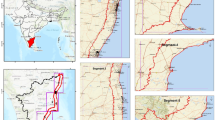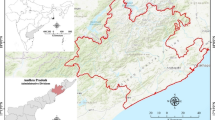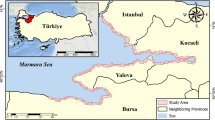Abstract
The vulnerability of coastal regions to climate change is a growing global concern, particularly in Bangladesh, which is vulnerable to flooding and storm surges due to its low-lying coastal areas. In this study, we used the fuzzy analytical hierarchy process (FAHP) method to assess the physical and social vulnerability of the entire coastal areas of Bangladesh, using 10 critical factors to evaluate the coastal vulnerability model (CVM). Our analysis indicates that a significant portion of the coastal regions of Bangladesh is vulnerable to the impacts of climate change. We found that one-third of the study area, encompassing around 13,000 km2, was classified as having high or very high coastal vulnerability. Districts in the central delta region, such as Barguna, Bhola, Noakhali, Patuakhali, and Pirojpur, were found to have high to very high physical vulnerability. Meanwhile, the southern parts of the study area were identified as highly socially vulnerable. Our findings also showed that the coastal areas of Patuakhali, Bhola, Barguna, Satkhira, and Bagerhat were particularly vulnerable to the impacts of climate change. The coastal vulnerability map we developed using the FAHP method showed satisfactory modeling, with an AUC of 0.875. By addressing the physical and social vulnerability factors identified in our study, policymakers can take proactive steps to ensure the safety and wellbeing of coastal residents in the face of climate change.








Similar content being viewed by others
Data availability
The datasets used and/or analyzed during the current study are available from the corresponding author on reasonable request.
Notes
Please note that the information provided is a summary, and for more specific details and comprehensive reports on damages, it is recommended to refer to official government reports. Ministry of Disaster Management and Relief, Bangladesh: http://www.modmr.gov.bd/
Department of Disaster Management, Bangladesh: http://www.ddm.gov.bd/
References
Ahmed N, Howlader N, Hoque MAA, Pradhan B (2021) Coastal erosion vulnerability assessment along the eastern coast of Bangladesh using geospatial techniques. Ocean Coast Manag 199:105408
Alam A, Sammonds P, Ahmed B (2020) Cyclone risk assessment of the Cox’s Bazar district and Rohingya refugee camps in southeast Bangladesh. Sci Total Environ 704:135360
Al Mamun A, Islam ARMT, Alam GM, Sarker MNI, Erdiaw-Kwasie MO, Bhandari H, Mallick J (2022) Livelihood vulnerability of char land communities to climate change and natural hazards in Bangladesh: an application of livelihood vulnerability index. Natural Hazards 115:1411–1437. https://doi.org/10.1007/s11069-022-05599-y
Baig MRI, Shahfahad Ahmad IA., Tayyab M, Asgher MS, Rahman A (2021) Coastal vulnerability mapping by integrating geospatial techniques and analytical hierarchy process (AHP) along the Vishakhapatnam coastal tract, Andhra Pradesh, India. J Indian Soc Remote Sens 49(2):215–231. https://doi.org/10.1007/s12524-020-01204-6
Bhowmik AK, Cabral P (2013) Space-time variability of summer temperature field over Bangladesh during 1948-2007. In: Computational Science and Its Applications–ICCSA 2013: 13th International Conference, Ho Chi Minh City, Vietnam, 24-27 June 2013. (Proceedings Part IV 13). Springer Berlin Heidelberg, p 120–135
Dewan AM (2013) Floods in a megacity: geospatial techniques in assessing hazards, risk and ... - Ashraf Dewan - Google Książki. Springer. https://books.google.at/books?hl=pl&lr=&id=AadEAAAAQBAJ&oi=fnd&pg=PR7&dq=Flood-vulnerability+of+Areas+Using+Satellite+Remote-sensing+Images+in+Kumamoto+City,+Japan.+In+Geospatial+Technology+for+Water+Resource+Applications+%3B+CRC+Press:+Boca+Raton,+FL,+US. Accessed Sept 2020
Didar-Ul Islam SM, Bhuiyan MA, Ramanathan AL (2015) Climate change impacts and vulnerability assessment in coastal region of Bangladesh: a case study on Shyamnagar Upazila of Satkhira District. J Clim Change 1(1–2):37–45
Furlan E, DallaPozza P, Michetti M, Torresan S, Critto A, Marcomini A (2021) Development of a multi-dimensional coastal vulnerability index: assessing vulnerability to inundation scenarios in the Italian coast. Sci Total Environ 772:144650
Füssel HM, Klein RJT (2006) Climate change vulnerability assessments: an evolution of conceptual thinking. Clim Change 75(3):301–329. https://doi.org/10.1007/s10584-006-0329-3
Ghosh S, Mistri B (2021) Assessing coastal vulnerability to environmental hazards of Indian Sundarban delta using multi-criteria decision-making approaches. Ocean Coast Manag 209. https://doi.org/10.1016/j.ocecoaman.2021.105641
Groen J, Kutzbach M, Polivka A (2015) Storms and jobs: the effect of hurricanes on individuals’ employment and earnings over the long term. In US Census Bureau Center for Economic Studies Paper No. CES-WP-15–21R; U.S. Census Bureau, Center for Economic Studies 2K132B: Washington, DC, USA. https://www2.census.gov/ces/wp/2015/CES-WP-15-21.pdf
Hamid AIA, Din AHM, Yusof N, Abdullah NM, Omar AH, Abdul Khanan MF (2019) Coastal vulnerability index development: a review Int Arch Photogramm Remote Sens Spatial Inf Sci XLII-4/W16:229–235. https://doi.org/10.5194/isprs-archives-XLII-4-W16-229-2019
Hejazi SJ, Sharifi A, Arvin M (2022) Assessment of social vulnerability in areas exposed to multiple hazards: a case study of the Khuzestan Province, Iran. Int J Disast Risk Reduct 78:103127
Hoque MAA, Phinn S, Roelfsema C, Childs I (2017) Tropical cyclone disaster management using remote sensing and spatial analysis: a review. Int J Disast Risk Reduct 22:345–354. https://doi.org/10.1016/j.ijdrr.2017.02.008
Hoque MAA, Phinn S, Roelfsema C, Childs I (2018) Assessing tropical cyclone risks using geospatial techniques. Appl Geogr 98:22–33
Hoque MAA, Tasfia S, Ahmed N, Pradhan B (2019) Assessing Spatial Flood Vulnerability at Kalapara Upazila in Bangladesh Using an Analytic Hierarchy Process. Sensors 19:1302. https://doi.org/10.3390/S19061302
Hoque MAA, Pradhan B, Ahmed N, Ahmed B, Alamri AM (2021) Cyclone vulnerability assessment of the western coast of Bangladesh. Geomat Nat Haz Risk 12(1):198–221
Hossain SA, Mondal I, Thakur S, Al-Quraishi AMF (2022) Coastal vulnerability assessment of India’s Purba Medinipur-Balasore coastal stretch: a comparative study using empirical models. Int J Disast Risk Reduct 77:103065
Hsiang SM, Jina AS (2014) The causal effect of environmental catastrophe on long-run economic growth: evidence from 6700 cyclones. National Bureau of Economic Research, Cambridge, MA, USA
Islam SS, Tanim AH, Mullick MRA (2020) Vulnerability assessment of Bangladesh coastline using Gornitz method. In Water, Flood Management and Water Security Under a Changing Climate: Proceedings from the 7th International Conference on Water and Flood Management. Springer International Publishing. pp 301–313
Koroglu A, Ranasinghe R, Jiménez JA, Dastgheib A (2019) Comparison of coastal vulnerability index applications for Barcelona Province. Ocean Coast Manag 178:104799
Lau YY, Yip TL, Dulebenets MA, Tang YM, Kawasaki T (2022) A review of historical changes of tropical and extra-tropical cyclones: a comparative analysis of the United States, Europe, and Asia. Int J Environ Res Public Health 19(8):4499
Mahmood R, Ahmed N, Zhang L, Li G (2020) Coastal vulnerability assessment of Meghna estuary of Bangladesh using integrated geospatial techniques. Int J Disaster Risk Reduct 42:101374
Mullick MRA, Tanim AH, Islam SMS (2019) Coastal vulnerability analysis of Bangladesh coast using fuzzy logic based geospatial techniques. Ocean Coast Manag 174:154–169. https://doi.org/10.1016/j.ocecoaman.2019.03.010
Nageswara Rao K, Subraelu P, Venkateswara Rao T, HemaMalini B, Ratheesh R, Bhattacharya S, Rajawat AS (2008) Sea-level rise and coastal vulnerability: an assessment of Andhra Pradesh coast, India through remote sensing and GIS. J Coast Conserv 12(4):195–207
Noor NM, Abdul Maulud KN (2022) Coastal vulnerability: a brief review on integrated assessment in southeast Asia. J Mar Sci Eng 10(5):595
Pantusa D, D’Alessandro F, Frega F, Francone A, Tomasicchio GR (2022) Improvement of a coastal vulnerability index and its application along the Calabria Coastline, Italy. Sci Rep 12(1):21959
Quader MA, Khan AU, Kervyn M (2017) Assessing risks from cyclones for human lives and livelihoods in the coastal region of Bangladesh. Int J Environ Res Public Health 14(8):831
Rahman M, Hossain M, Ali M, Ahmed Z, Hedayutul Islam AHM (2022a) Assessing vulnerability and adaptation strategy of the cyclone affected coastal area of Bangladesh. Geoenviron Dis 9(1):1–20
Rahman MM, Arif MSI, Mahdi I, Rafi MA, Chisty MA, Khan SJ (2022b) Cyclone vulnerability in ethnic minority: a case study among rakhain community of Bangladesh. Int J Disast Risk Reduct 83:103449
Saaty TL (1980) The Analytic Hierarchy Process. McGraw-Hill, New York
Szlafsztien CF (2005) Climate change, sea-level rise and coastal natural hazard: a GIS-based vulnerability assessment, state of Pará, Brazil. J Coast Conserv 11:53–66
Talukdar S, Pal S, Singha P (2021) Proposing artificial intelligence based livelihood vulnerability index in river islands. J Clean Prod 284:124707
Wu CR, Lin CT, Lin YF (2009) Selecting the preferable bancassurance alliance strategic by using expert group decision technique. Expert Syst Appl 36(2):3623–3629
Youssef AM, Pourghasemi HR, Pourtaghi ZS, Al-Katheeri MM (2016) Landslide susceptibility mapping using random forest, boosted regression tree, classification and regression tree, and general linear models and comparison of their performance at Wadi Tayyah Basin. Asir Region, Saudi Arabia Landslides 13:839–856
Acknowledgements
The authors extend their appreciation to the Deanship of Scientific Research at King Khalid University for funding this work through Research Group under grant number G.P2/411/44. The authors are also thankful to the USGS Earth Explorer for making the Landsat data freely available.
Funding
Funding for this research was given under award numbers R.G.P2/411/44 by the Deanship of Scientific Research; King Khalid University, Ministry of Education, Kingdom of Saudi Arabia.
Author information
Authors and Affiliations
Contributions
Conceptualization: Shahriar Hasnat Akash, Showmitra Kumar Sarkar, and Ahmed Ali Bindajam; data curation: Shahriar Hasnat Akash, Showmitra Kumar Sarkar, Swapan Talukdar, and Javed Mallick; formal analysis: Shahriar Hasnat Akash and Showmitra Kumar Sarkar; funding acquisition: Ahmed Ali Bindajam; methodology: Shahriar Hasnat Akash and Showmitra Kumar Sarkar; project administration: Javed Mallick and Rina Kumari; resources: Shahriar Hasnat Akash, Showmitra Kumar Sarkar, and Rina Kumari; software: Swapan Talukdar; supervision: Javed Mallick and Rina Kumari; validation: Shahriar Hasnat Akash, Showmitra Kumar Sarkar, and Swapan Talukdar; writing—original draft: Shahriar Hasnat Akash, Showmitra Kumar Sarkar, Swapan Talukdar, and Ahmed Ali Bindajam; writing—review and editing: Javed Mallick and Rina Kumari.
Corresponding author
Ethics declarations
Ethics approval and consent to participate
Not applicable.
Consent for publication
Not applicable.
Competing interests
The authors declare no competing interests.
Additional information
Responsible Editor: V.V.S.S. Sarma
Publisher's note
Springer Nature remains neutral with regard to jurisdictional claims in published maps and institutional affiliations.
Rights and permissions
Springer Nature or its licensor (e.g. a society or other partner) holds exclusive rights to this article under a publishing agreement with the author(s) or other rightsholder(s); author self-archiving of the accepted manuscript version of this article is solely governed by the terms of such publishing agreement and applicable law.
About this article
Cite this article
Akash, S.H., Sarkar, S.K., Bindajam, A.A. et al. Assessment of coastal vulnerability using integrated fuzzy analytical hierarchy process and geospatial technology for effective coastal management. Environ Sci Pollut Res (2023). https://doi.org/10.1007/s11356-023-28317-y
Received:
Accepted:
Published:
DOI: https://doi.org/10.1007/s11356-023-28317-y




